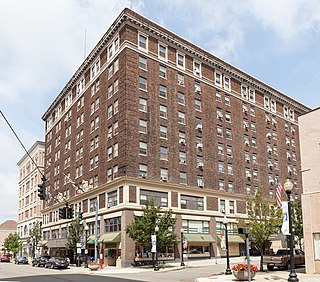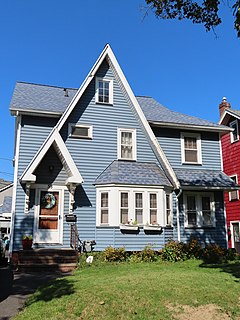
Cattaraugus is a village in Cattaraugus County, New York, United States. The population was 1,002 at the 2010 census. The village lies in the northeast part of the town of New Albion, north of Salamanca.

There are 73 properties listed on the National Register of Historic Places in Albany, New York, United States. Six are additionally designated as National Historic Landmarks (NHLs), the most of any city in the state after New York City. Another 14 are historic districts, for which 20 of the listings are also contributing properties. Two properties, both buildings, that had been listed in the past but have since been demolished have been delisted; one building that is also no longer extant remains listed.

Ellicottville Historic District is a historic district located at Ellicottville in Cattaraugus County, New York. The district encompasses the historic core of the village of Ellicottville with structures associated with the civic, commercial, religious, educational, and residential life of the village between 1817 and 1935. The structures reflect a variety of 19th-century and early 20th-century architectural styles including Queen Anne, Federal, and Greek Revival styles. The district contains 63 contributing and 3 non-contributing structures. Located within the district is the Ellicottville Town Hall.

Gowanda Village Historic District is a historic district located at Gowanda in Cattaraugus County, New York. The district encompasses five early 20th century commercial buildings constructed 1925–1926. The Neoclassical style structures housed the Gowanda Cooperative Savings and Loan Association, Hollywood Theater, U.S. Post Office, and Gowanda's first department store.

Park Square Historic District is a historic district located at Franklinville in Cattaraugus County, New York. The district encompasses the historic core of the village of Franklinville and include the landscaped village green, brickpaved streets, and the commercial or civic buildings fronting on the square or located immediately adjacent to it. Significant buildings range in date from 1828 to 1924 and reflect a variety of 19th-century and early 20th-century architectural styles including Queen Anne, Italianate, and Classical Revival styles. The village square was established in 1876. The district contains 21 contributing buildings and 2 contributing structures.

The Lee, Higginson & Company Bank Building is a historic bank building located at 41 Broad Street in the Financial District of Lower Manhattan, New York City. The structure was designed by architects Cross & Cross and built in 1928–1929. It is a 10-story, Classical Revival style, with a top floor penthouse. It features a slightly curved front facade, architectural sculpture by Leo Friedlander, and murals by Griffith B. Coale.

Randolph Historic District is a national historic district located at Randolph in Cattaraugus County, New York. The district encompasses 268 contributing buildings, 1 contributing site, and 1 contributing structure in the hamlet of Randolph. The district includes a variety of residential, commercial, industrial, and institutional buildings primarily dating between 1826 and the 1880s. There are representative examples of Greek Revival and Italianate architectural styles. Notable buildings include the Borden's Condensery (1907), Borden's Caretaker's House (1907), Town Hall, Dow Library, Addison Crowley Residence, The Adams Building (1874), State Bank (1874), Alexander Davis House (1851), Thaddeus S. Sheldon Residence (1851), Albert G. Dow House (1865), Resolved Sears House (1850), and St. Patrick's Roman Catholic Church (1876). The contributing site is The Point, a public park.

Central Avenue Historic District is a national historic district located at Lancaster in Erie County, New York. The district encompasses 17 contributing buildings in the central business district of the village of Lancaster. The district includes a variety of residential, commercial, and government buildings built between about 1860 and 1940. It includes notable examples of Italianate and Colonial Revival style architecture. Notable buildings include the Lancaster Town Hall and Opera House, Former Post Office, Cushing Block, and Potter-Eaton House.

Market Square Historic District is a national historic district located in the Black Rock neighborhood of Buffalo in Erie County, New York. The district encompasses 15 contributing buildings and 1 contributing site in a mixed residential and commercial section of Buffalo. The district developed between about 1830 and 1912, and includes a buildings in a variety of architectural styles including Federal, Gothic Revival, Italianate, Queen Anne, Romanesque Revival, and Bungalow / American Craftsman. Located in the district is the separately listed St. Francis Xavier Roman Catholic Parish Complex. Other notable contributing resources include the Market Square (1830), Black Rock Savings and Loan (1870-1910), Firehouse Engine #15 (1912), Smith House and Tavern, St. John's Church (1894), and Howell House and Store.

High and Locust Streets Historic District is a national historic district located at Lockport in Niagara County, New York. The district encompasses 120 contributing buildings in a predominantly residential section of Lockport. The district developed between about 1840 and 1936, and includes buildings in a variety of architectural styles including Greek Revival, Italianate, Queen Anne, Colonial Revival, Classical Revival, and Bungalow / American Craftsman. Located in the district are the separately listed Chase-Crowley-Keep House, Chase-Hubbard-Williams House, and Thomas Oliver House. Other notable buildings include the F.N. Nelson House, Calvin Haines/Alonzo J. Mansfield House, J. Dunville House, Ambrose S. Beverly House, Dr. Martin S. Kittinger House, and F. N. Nelson House/Lockport Home for the Friendless.

Leon Grange No. 795, also known as the Aiken-Silvernail House, is a historic home located at Leon in Cattaraugus County, New York. It was built in 1903–1904, and is a two-story, three bay by four bay, frame building. It has a gable roof and is sheathed in clapboard siding. The building has housed the Leon Historical Society since 1977.

Jamestown Downtown Historic District is a national historic district located at Jamestown in Chautauqua County, New York. The district encompasses 103 contributing buildings in the central business district of Jamestown. The district developed between about 1873 and 1956, and includes buildings in a variety of architectural styles including Italianate, Gothic Revival, Second Empire, Romanesque Revival, Classical Revival, Renaissance Revival, and Art Deco. Located in the district is the separately listed Wellman Building. Other notable buildings include the Arcade Building (1898), Odd Fellows Lodge (1914), Bank of Jamestown, Hotel Samuels (1910), Hotel Jamestown (1924), Chautauqua School of Nursing (1911), Jamestown Telephone Company (1930), Maddox Building (1933), First National Bank (1953), Pennsylvania Gas Company building, Chautauqua National Bank (1956), Palace Theatre, Allen's Opera House, and the former Broadhead Worsted Mills.

Geneva Downtown Commercial Historic District is a national historic district located at Geneva, Ontario County, New York. It encompasses 83 contributing buildings in the central business district of Geneva. They were built between about 1840 and 1940, and include notable examples of Greek Revival, Italianate, Romanesque Revival, Colonial Revival, and Art Deco style commercial architecture. Located in the district are the separately listed Farmers and Merchants Bank, Smith's Opera House, and United States Post Office. Other notable buildings include the Prouty Block (1876), YMCA (1902), Wheat Building (1904), Guard Building, Geneva City Hall, Odd Fellows Building (1884-1890), and Kresge Building (1928).

Watkins Glen Commercial Historic District is a national historic district located at Watkins Glen in Schuyler County, New York. It encompasses 33 contributing buildings in the central business district of Watkins Glen. It developed between about 1844 and 1939 and includes notable examples of Greek Revival, Italianate, Classical Revival, Colonial Revival, Second Empire and Romanesque Revival style architecture. Notable buildings include the Watkins Glen Municipal Building (1939), Watkins Glen Fire Station (1935), Watkins State Bank (1911), Hotel Kendall (1891), Haring Building (1844), former Watkins Post Office (1905), Freer Opera House, and the Durand Block (1897).

Crown Heights North Historic District is a national historic district located in the Crown Heights neighborhood of Brooklyn, Kings County, New York. The district encompasses 1,019 contributing buildings in a predominantly residential section of Brooklyn. The district features noteworthy examples of Greek Revival, Gothic Revival, Italianate, Second Empire, Queen Anne, Romanesque Revival, Renaissance Revival, Beaux-Arts, and Colonial Revival style architecture. It largely developed between about 1853 and 1942, and consists of densely constructed rowhouses, townhouses, two-family houses, semi-attached houses, freestanding houses, flats, apartment buildings, and institutional and commercial buildings.

East Hill Historic District is a national historic district located at Springville in Erie County, New York. The district encompasses 59 contributing buildings and 2 contributing objects in the original residential district of the village of Springville. The district includes a variety of residential buildings built between about 1835 and 1935. It includes notable examples of Greek Revival, Italianate, Queen Anne, Colonial Revival, and Bungalow / American Craftsman style architecture. Notable buildings include the George E. Crandall House / Warner Museum, Frank O. Smith House, C.J. Shuttleworth House, Morris Hall House (1892), and Inez Wiggins House.

Broadway Historic District is a national historic district located at Lancaster in Erie County, New York. The district encompasses 85 contributing resources in the village of Lancaster. The district includes a variety of commercial, residential, religious and institutional buildings built between about 1831 and 1940. It includes notable examples of Greek Revival, Italianate, Queen Anne, Colonial Revival, and Bungalow / American Craftsman style architecture. Located in the district are the separately listed Lancaster Municipal Building (1940), Miller-Mackey House, Clark-Lester House, Bruce-Briggs Brick Block, Lancaster Masonic Lodge Hall (1916-1919), Liebler-Rohl Gasoline Station, Dr. John J. Nowak House, Zuidema-Idsardi House, Herman B. VanPeyma House, and John Richardson House. Other notable buildings include the Seeger Store Building, Brost Building designed by Edward Brodhead Green, Maute House, Depew Lancaster Moose Lodge No. 1605 B.P.O.E. Lodge/Potter's Hall, and Lancaster Presbyterian Church (1832-1833).

Arvine Heights Historic District is a national historic district located at Rochester, Monroe County, New York. The district encompasses 61 contributing buildings in an exclusively residential section of Rochester. The district developed between about 1920 and 1942, and includes residential buildings in a variety of architectural styles including Colonial Revival, Tudor Revival, and Bungalow / American Craftsman. The dwellings reflect modest designs directed toward a middle-class clientele in a newly developing area of Rochester's Nineteenth Ward.

Chili–West Historic District is a national historic district located at Rochester, Monroe County, New York. The district encompasses 508 contributing buildings in a predominantly residential section of Rochester. The district developed between about 1874 and 1935, and includes buildings in a variety of architectural styles including Queen Anne, Colonial Revival, Gothic Revival, and Tudor Revival, Mission Revival, and Bungalow / American Craftsman. The dwellings reflect designs directed toward a middle-class and working class clientele in a newly developing area of Rochester's Nineteenth Ward. Located in the district is the former St. Augustine Roman Catholic Church complex.

Helen Hill Historic District is a national historic district located at Saranac Lake, Essex County and Franklin County, New York. It encompasses 77 contributing buildings and 38 contributing structures in a predominantly residential section of Saranac Lake. It developed between about 1856 and 1954, and includes notable examples of Queen Anne, Colonial Revival, Tudor Revival, and Bungalow / American Craftsman style architecture. The district is characterized by many cottages retaining the "cure porches" that distinguished the area's early days as a sanitarium. Located in the district are the separately listed Bogie Cottage, Coulter Cottage, Fallon Cottage Annex, Hill Cottage, Hooey Cottage, Kennedy Cottage, Lent Cottage, Marvin Cottage, and Noyes Cottage. Other notable buildings include the Cure Cottage Museum and Mary Prescott Reception Hospital.
























